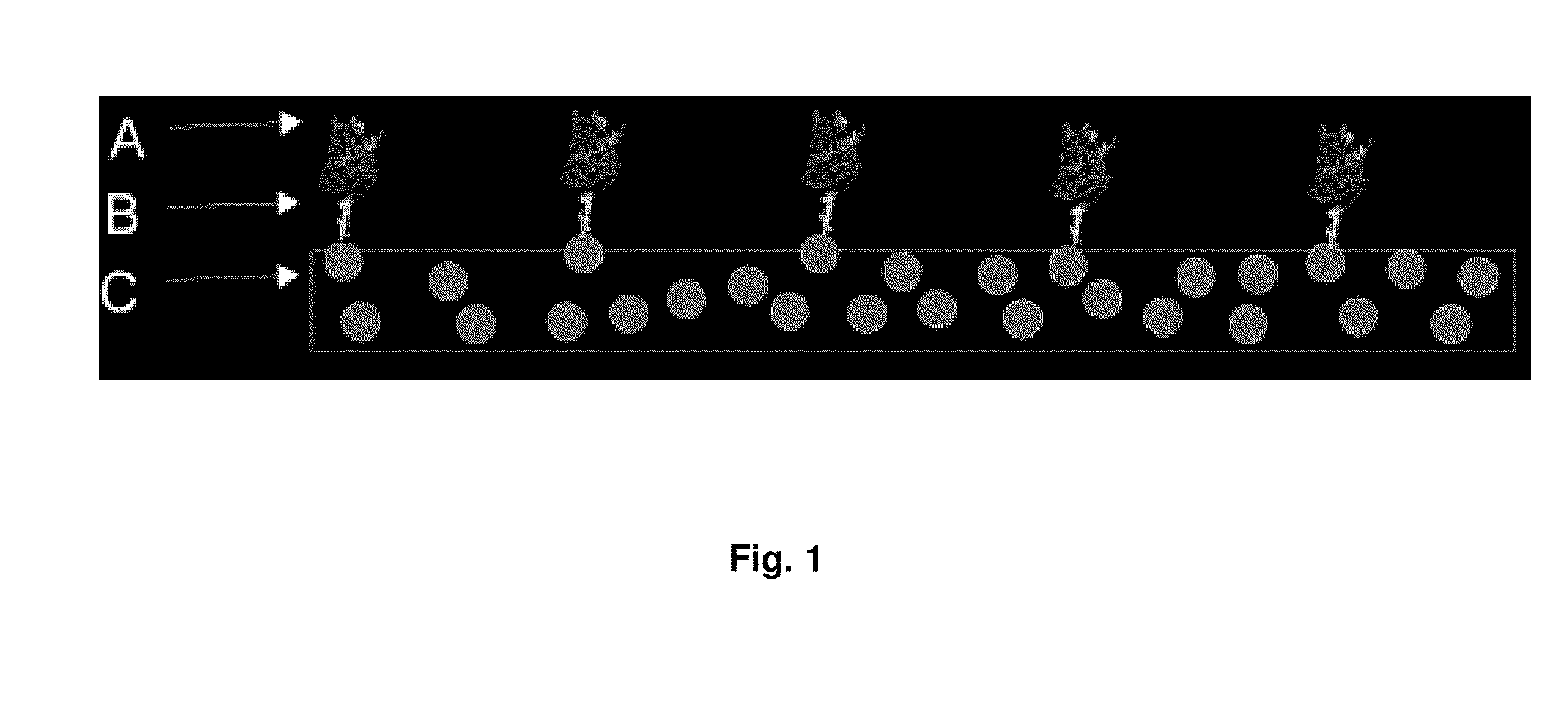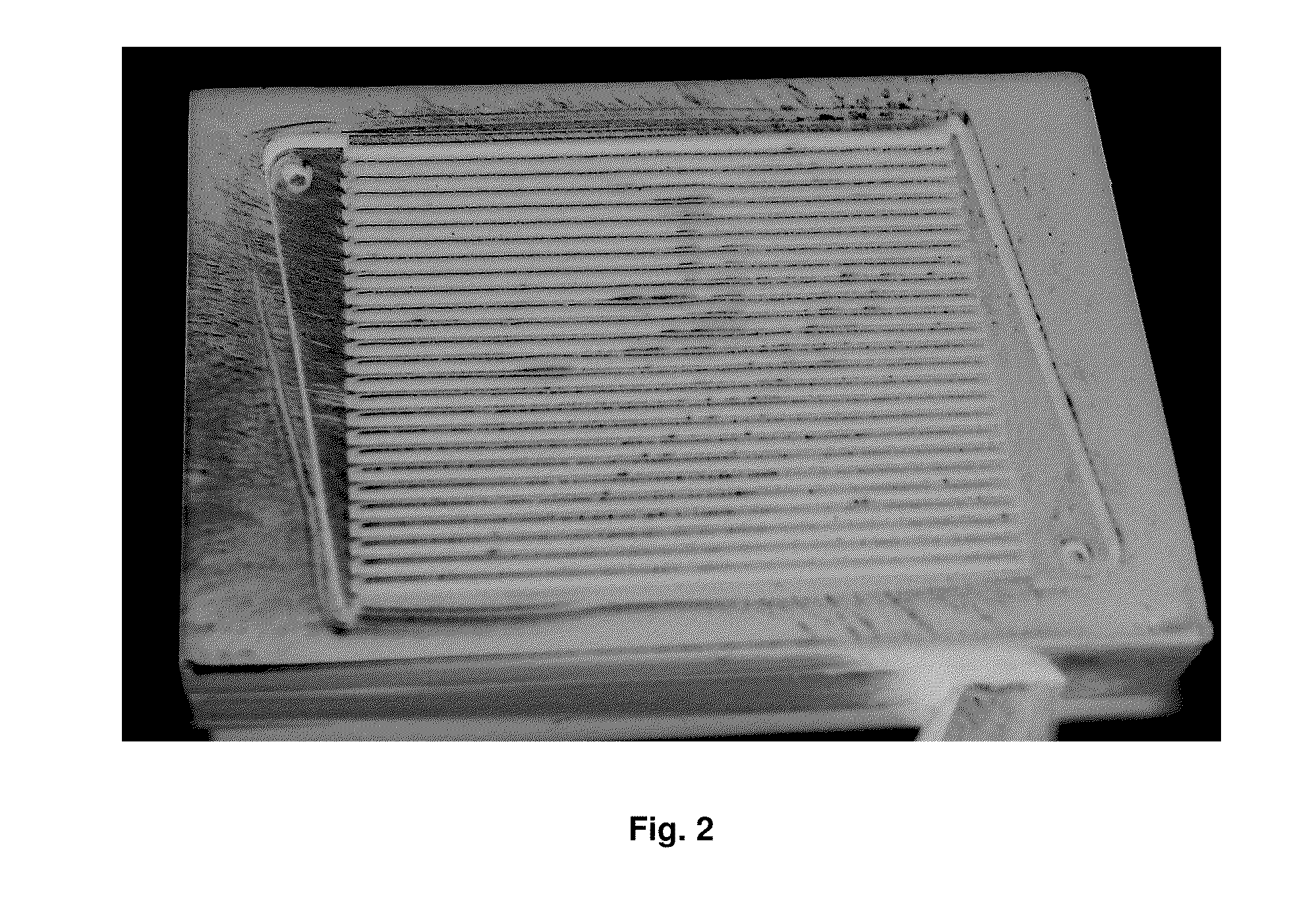Molding with embedded coupling particles for biomolecules
- Summary
- Abstract
- Description
- Claims
- Application Information
AI Technical Summary
Benefits of technology
Problems solved by technology
Method used
Image
Examples
example 1
Manufacture of Moldings
[0096]For the coupling of biomolecules to solid centers (coupling particles) in the first step a composite is manufactured from the respective solid in powder form and a thermoplastic polymer. Manufacture takes place in a temperature-controlled mixer, which heats the thermoplastics to above the heat distortion temperature and plasticizes them through mechanical working. For the manufacture of the composites used a Brabender Plastograph was employed.
[0097]For the dispersion the thermoplastic was placed in the pre-heated mixer and plasticized through mechanical shearing forces. Then the coupling particles were added dry as an ultrafine powder. After a mixing time of approximately 60 minutes the material was cooled slowly. The result was a granulate.
[0098]For the manufacture of the material composite, various material combinations were considered. For the base synthetic material, polypropylene (PP), polystyrene (PS), polyethylene (PE) and polyurethane (PUR) were ...
example 2
Moldings
[0104]As a further geometry, in the injection molding method, spherical-cylindrical moldings were manufactured. Table 4 gives an overview of the material combinations produced:
TABLE 4Material combination for spherical-cylindrical moldingsContent ofDwellcouplingpressureparticlesMixingMixerInjectionAirfor 30SyntheticCoupling[% bytemperaturetimemoldingpressuresecondmaterialparticlevolume][° C.][min]temperature[bar]settingPEXX1251512540.5PEXXXX12540.5PEGlass1012515128-13040.5(S38)PENickel1012515128-13040.5(Novamet)
[0105]FIG. 3 shows injection molded parts (moldings) with 10% by volume of glass balls (average particle diameter of 20 μm) in a polyethylene matrix.
[0106]For the biochemical reaction (coupling) the active centers (glass balls) must now be exposed. This can take place by means of various methods, such as for example chemical or plasma-chemical etching. With these methods, however, often new unselective active centers in the form of carboxyl or similar groups are activa...
application example 1
Polyethylene Bars with Silanized ITO Particles
[0108]The covalent coupling of biomolecules to fixed particles in polymers offers the possibility of creating a biochemical sensor. For this, however, another evaluation or recognition of the coupling process is necessary. A very simple and at the same time effective possibility is offered by electrical evaluation of surface changes or surface potentials. A necessary basic condition for this is a sufficiently high electrical conductivity of the specimen. Since the coupling of the biomolecules is to take place with the coupling particles introduced, these particles should demonstrate sufficient electrical conductivity. As a coupling mechanism the binding of a silane to an oxide layer was selected. The necessary properties set out here bind semi-conductive oxides, such as for example indium tin oxide ITO. Through the combination of such oxides in an electrical non-conducting polymer such as for example polyethylene, the possibility arises ...
PUM
| Property | Measurement | Unit |
|---|---|---|
| Fraction | aaaaa | aaaaa |
| Fraction | aaaaa | aaaaa |
| Fraction | aaaaa | aaaaa |
Abstract
Description
Claims
Application Information
 Login to View More
Login to View More - R&D
- Intellectual Property
- Life Sciences
- Materials
- Tech Scout
- Unparalleled Data Quality
- Higher Quality Content
- 60% Fewer Hallucinations
Browse by: Latest US Patents, China's latest patents, Technical Efficacy Thesaurus, Application Domain, Technology Topic, Popular Technical Reports.
© 2025 PatSnap. All rights reserved.Legal|Privacy policy|Modern Slavery Act Transparency Statement|Sitemap|About US| Contact US: help@patsnap.com



